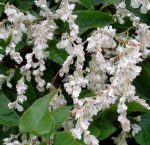
This deciduous woody twining perennial vine is also known as Russian-vine, Bukhara fleeceflower, Chinese bindweed, and mile-a-minute vine. It is a member of the knotweed family, Polygonaceae, that also includes buckwheat, rhubarb, and dock. Although native to China, Russia, Kazakhstan and other parts of western Asia, when it was introduced into the US it became an invasive weed in some areas. The vine can grow 15’/year and up to 35″ long. It has twisting reddish-green stems and arrowhead-shaped leaves up to 4″ long on twisted petioles. From mid-summer into fall, 6-8″ long clusters of drooping small white to greenish or pink flowers appear that are 1/2″ long, 5 lobed, fragrant, and attractive to honeybees. The fruit is a tiny black achene. Plants are tolerant of drought, and urban and seaside conditions, and are frequently used to cover unsightly structures in gardens. They can quickly become out of control and cover shrubs and small trees so must be used with great care especially since eradication is very difficult. The genus name Polygonum comes from the Greek words poly meaning many and goni meaning knee or joint and refers to the swollen nodes on the stems of some species. The specific epithet, aubertii, honors Georges Eleosippe Aubert, 19th century French missionary in Western China.
Type: Woody, deciduous, perennial vine
Bloom: Drooping clusters of greenish, white, to pink flowers from mid-summer to fall
Size: 35′ long
Light:Full sun to light shade
Soil: Average to lean, moderately moist to dry, well-drained
Hardiness: Zones 4-7
Care: Prune any time; contain as necessary.
Pests and Diseases: Japanese beetles
Propagation: Seed, stem cuttings, division of rhizomes
Photo Credit: Wikipedia